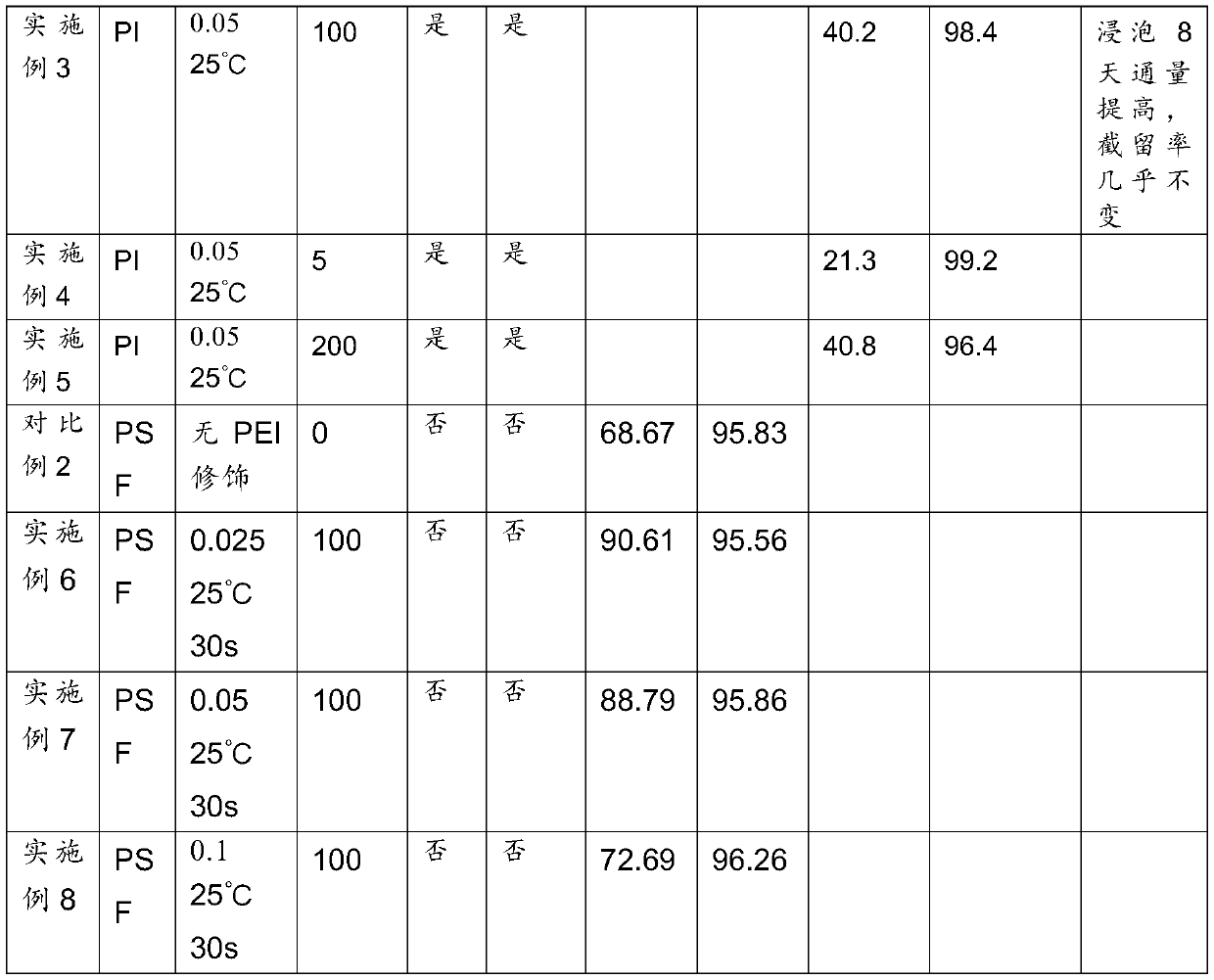Ultra-thin composite film and preparation method thereof
A composite membrane, ultra-thin technology, applied in the field of membrane separation, can solve the problems of low flux of nanofiltration membrane, membrane intolerance to pollution, poor solvent resistance, etc., achieve strong quantum effect, improve hydrophilicity, and improve separation performance. Effect
- Summary
- Abstract
- Description
- Claims
- Application Information
AI Technical Summary
Problems solved by technology
Method used
Image
Examples
Embodiment 1
[0075] The concentration is 100mg·L -1 The GQDs aqueous solution was sonicated for 60 min and set aside. The average thickness of the GQDs is 1.8nm; the average thickness of the GQDs is 1.9nm.
[0076] The film making steps are as follows:
[0077] Step 1: After fully contacting the base film with a polyethyleneimine solution with a concentration of 0.005wt% at 25°C for 30 seconds, remove the modifier remaining on the surface of the base film and dry it, then fully contact it with the GQDs aqueous solution for 60 seconds, and remove the surface of the film The free suspension was dried to obtain a modified hybrid membrane;
[0078] Step 2: After fully contacting the modified hybrid membrane obtained in step 1 with the aqueous phase monomer solution for 120 seconds, remove the aqueous phase monomer solution on the surface of the basement membrane and dry for 45 seconds; mix the dried membrane with the organic phase monomer solution The solution was fully contacted for 60 sec...
Embodiment 2
[0085] The difference from Example 1 is that in step 1, the polyimide base film is fully contacted with 0.025 wt % polyethyleneimine at 25° C. for 30 s.
[0086] All other steps are identical with embodiment 1;
[0087] The test conditions are the same as in Comparative Example 1.
[0088] The prepared multifunctional hybrid composite nanofiltration membrane has a rejection rate of 98.2% for rhodamine B, and a flux of ethanol of 33.8 LMH, which is much higher than that of the comparative example.
Embodiment 3
[0090] The difference from Example 2 is that the concentration of polyimide used in step 1 is 0.05wt%.
[0091] All other steps are the same as in Example 1.
[0092] The test conditions are the same as in Comparative Example 1.
[0093] The average thickness of the separated cortex is 25nm, and the average roughness is less than 2.0nm.
[0094] The prepared ultra-thin composite nanofiltration membrane has a rejection rate of 98.4% for rhodamine B and a flux of ethanol of 40.2LMH, which is much higher than that of the comparative example.
[0095] The prepared multifunctional hybrid composite nanofiltration membrane was immersed in DMF at 80°C for 8 days, the flux of ethanol was 51.7LMH, and the rejection rate of rhodamine B was 98.3%. It shows that the prepared multifunctional hybrid composite nanofiltration membrane has good solvent resistance.
PUM
| Property | Measurement | Unit |
|---|---|---|
| thickness | aaaaa | aaaaa |
| concentration | aaaaa | aaaaa |
| thickness | aaaaa | aaaaa |
Abstract
Description
Claims
Application Information
 Login to View More
Login to View More - R&D
- Intellectual Property
- Life Sciences
- Materials
- Tech Scout
- Unparalleled Data Quality
- Higher Quality Content
- 60% Fewer Hallucinations
Browse by: Latest US Patents, China's latest patents, Technical Efficacy Thesaurus, Application Domain, Technology Topic, Popular Technical Reports.
© 2025 PatSnap. All rights reserved.Legal|Privacy policy|Modern Slavery Act Transparency Statement|Sitemap|About US| Contact US: help@patsnap.com


